A reblog of nerdy and quirky stuff that pique my interest.
291 posts
Latest Posts by philosophical-amoeba - Page 4

How many did you know? All worth reading more about!!
11 New Facts Science Has Revealed About The Body
1. Hundreds of genes spring to life after you die - and they keep functioning for up to four days.
2. Livers grow by almost half during waking hours.
3. The root cause of eczema has finally been identified.
4. We were wrong - the testes are connected to the immune system after all.
5. The causes of hair loss and greying are linked, and for the first time, scientists have identified the cells responsible.
6. A brand new human organ has been classified - the mesentery - an organ that’s been hiding in plain sight in our digestive system this whole time.
7. An unexpected new lung function has been found - they also play a key role in blood production, with the ability to produce more than 10 million platelets (tiny blood cells) per hour.
8. Your appendix might actually be serving an important biological function- and one that our species isn’t ready to give up just yet.
9. The brain literally starts eating itself when it doesn’t get enough sleep. brain to clear a huge amount of neurons and synaptic connections away.
10. Neuroscientists have discovered a whole new role for the brain’s cerebellum - it could actually play a key role in shaping human behaviour.
11. Our gut bacteria are messing with us in ways we could never have imagined. Neurodegenerative diseases like Parkinson’s might actually start out in the gut, rather than the brain, and there’s mounting evidence that the human microbiome could be to blame for chronic fatigue syndrome.
The Fibonacci sequence can help you quickly convert between miles and kilometers
The Fibonacci sequence is a series of numbers where every new number is the sum of the two previous ones in the series.
1, 1, 2, 3, 5, 8, 13, 21, etc. The next number would be 13 + 21 = 34.
Here’s the thing: 5 mi = 8 km. 8 mi = 13 km. 13 mi = 21 km, and so on.
Edit: You can also do this with multiples of these numbers (e.g. 5*10 = 8*10, 50 mi = 80 km). If you’ve got an odd number that doesn’t fit in the sequence, you can also just round to the nearest Fibonacci number and compensate for this in the answer. E.g. 70 mi ≈ 80 mi. 80 mi = 130 km. Subtract a small value like 15 km to compensate for the rounding, and the end result is 115 km.
This works because the Fibonacci sequence increases following the golden ratio (1:1.618). The ratio between miles and km is 1:1.609, or very, very close to the golden ratio. Hence, the Fibonacci sequence provides very good approximations when converting between km and miles.

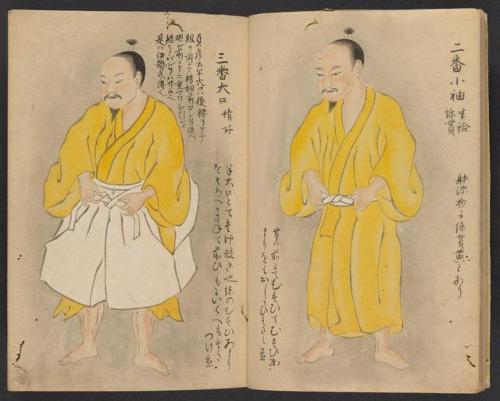




Dress for the job you want.
Yoshiie Ason yoroi chakuyōzu 義家朝臣鎧着用次第 by Sadatake Ise is a pictorial work on how to put on Japanese Samurai armor. The subject is famed Samurai warrior Minamoto No Yoshiie.
Find more amazing rare books we’ve recently digitized from our Freer | Sackler branch library in our book collection, Japanese Illustrated Books from the Edo and Meiji Period.
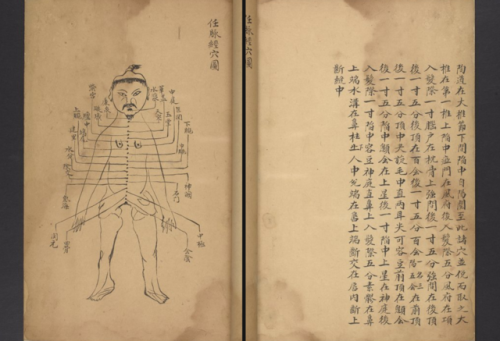
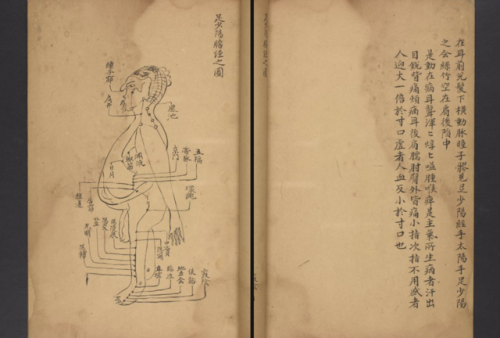



This week, we’re taking a look at manuscripts having to do with health, medicine, and human physiology specifically focusing on how bodies are displayed in manuscript illuminations or diagrams across different cultures.
LJS 389 shown above, is a 14th century Chinese treatise on the anatomy, physiology, and pathology of blood vessels titled Shi si jing fa hui. The manuscript is made from bamboo paper and the diagrams and kaishu script are written with black ink. Focus on the diagrams of the bodies and stay tuned this week to see not only how the details and forms of these depictions change from culture to culture, but also the mediums with which these manuscripts are created.
The full LJS 389 manuscript filled with more diagrams can be found on Openn: http://openn.library.upenn.edu/Data/0001/html/ljs389.html
and Penn In Hand: http://hdl.library.upenn.edu/1017/d/medren/4824235
Did You Know Large Wine Bottles Have Special Names?

Wine bottle names are… odd. Once you get large enough, the wine holders become named after biblical kings:
1.5 L Magnum: Equivalent to two standard 750 ml bottles.
3.0 L Double Magnum: Equivalent to two Magnums or four standard 750 ml bottles.
4.5 L Jeroboam : Equivalent to six standard 750 ml bottles.
6.0 L Imperial: Equivalent to eight standard 750 ml bottles or two Double Magnums. Why they stopped using kings here I don’t know.
9.0 L Salmanazar: Equivalent to twelve standard 750 ml bottles or a full case of wine!
12.0 L Balthazar: Equivalent to sixteen standard 750 ml bottles or two Imperials.
15.0 L Nebuchadnezzar: Equivalent to twenty standard 750 ml bottles.
Interestingly, I looked around and could not find why the names are what they are. The names just appeared, I guess, and everyone agreed to use them.
Joan Beauchamp Procter: her best friend was a Komodo dragon and if that doesn’t entice you to read this, I don’t know what will
Joan Beauchamp Procter is a scientist every reptile enthusiast should admire.

Joan was an incredibly intelligent young woman who was chronically ill (and as a result of her chronic illness, physically disabled by her early thirties). Her health issues kept her from going to college, but that did not stop her from studying and keeping reptiles. She presented her first paper to the Zoological Society of London at the tender age of nineteen, and the society was so impressed that they hired her to help design their aquarium. In 1923, despite having no formal secondary education and despite being only 26 years old, she was hired as the London Zoo’s curator of reptiles. Now, that in and of itself is an awesome accomplishment, but Joan was absolutely not content to maintain the status quo. Nosiree, by the age of 26 Joan had already kept many exotic pets (including a crocodile!) and knew a thing or two about what needed to be done to improve their lives in captivity. So Joan got together with an architect, Edward Guy Dawber, and designed the world’s first building designed solely for the keeping of reptiles. She had some really, really great ideas. Her first big idea was to make the building differentially heated- different areas and enclosures would have different heat zones, instead of having the whole building heated to one warm temperature. She also set up aquarium lighting- the gallery itself was dark, with dim lights on individual enclosures to make things less stressful for the inhabitants. She also insisted on the use of special glass that didn’t filter out UVB. This meant that reptiles could synthesize vitamin D and prevented cases of MBD in her charges.

But advances in enclosure design weren’t Joan’s only contribution to reptile keeping. She was also one of the first herpetologists to study albinism in snakes- she was the first to publish an identification how albinism manifests in reptile eyes differently than in mammal eyes, and stressed the importance of making accurate color plates of reptiles during life because study specimens often lose pigmentation. She also was really hands-on with many species, including crocodiles, large constrictors, and monitor lizards. Joan had this idea that if you socialize an animal and get it used to handling, then when you need to give it a vet checkup, things tend to go a lot better. This really hadn’t been done with reptiles before. She was able to identify many unstudied diseases, thanks to her patient handling of live specimens, and by being patient and going slow, she managed to get a lot of very large, dangerous creatures to trust her. One of them (that we know of) even came to like her- a Komodo dragon named Sumbawa.

In 1928, two of the first Komodo dragons to be imported to Europe arrived at the London Zoo. One of them, named Sumbawa, came in with a nasty mouth infection. His first several months at the zoo were a steady stream of antibiotics and gentle care, and by the time he’d recovered enough for display, he had come to be tolerant of handling and human interaction. In particular, he seemed to be genuinely fond of Joan. She was their primary caretaker and wrote many of the first popular accounts of Komodo dragon behavior in captivity. While recognizing their lethal capacity, she also wrote about how smart they are and how inquisitive they could be. In her account published in The Wonders of Animal Life, she said that "they could no doubt kill one if they wished, or give a terrible bite" but also that they were “as tame as dogs and even seem to show affection.” To demonstrate this, she would take Sumbawa around on a leash and let zoo visitors interact with him. She would also hand-feed Sumbawa- pigeons and chickens were noted to be favorite food, as were eggs.
Joan died in 1931 at the age of 34. By that time she was Doctor Procter, as the University of Chicago had awarded her an honorary doctorate. Until her death, she still remained active with the Zoological Society of London- and she was still in charge of her beloved reptiles. Towards the end of her life, Joan needed a wheelchair. But that didn’t stop her from hanging out with her giant lizard friend. Sumbawa would walk out in front of the wheelchair or beside it, still on leash- she’d steer him by touching his tail. At her death, she was one of the best-known and respected herpetologists in the world, and her innovative techniques helped shape the future of reptile care.

The late effects of stress: New insights into how the brain responds to trauma
Mrs. M would never forget that day. She was walking along a busy road next to the vegetable market when two goons zipped past on a bike. One man’s hand shot out and grabbed the chain around her neck. The next instant, she had stumbled to her knees, and was dragged along in the wake of the bike. Thankfully, the chain snapped, and she got away with a mildly bruised neck. Though dazed by the incident, Mrs. M was fine until a week after the incident.
Then, the nightmares began.
She would struggle and yell and fight in her sleep every night with phantom chain snatchers. Every bout left her charged with anger and often left her depressed. The episodes continued for several months until they finally stopped. How could a single stressful event have such extended consequences?
A new study by Indian scientists has gained insights into how a single instance of severe stress can lead to delayed and long-term psychological trauma. The work pinpoints key molecular and physiological processes that could be driving changes in brain architecture.
The team, led by Sumantra Chattarji from the National Centre for Biological Sciences (NCBS) and the Institute for Stem Cell Biology and Regenerative Medicine (inStem), Bangalore, have shown that a single stressful incident can lead to increased electrical activity in a brain region known as the amygdala. This activity sets in late, occurring ten days after a single stressful episode, and is dependent on a molecule known as the N-Methyl-D-Aspartate Receptor (NMDA-R), an ion channel protein on nerve cells known to be crucial for memory functions.
The amygdala is a small, almond-shaped groups of nerve cells that is located deep within the temporal lobe of the brain. This region of the brain is known to play key roles in emotional reactions, memory and making decisions. Changes in the amygdala are linked to the development of Post-Traumatic Stress Disorder (PTSD), a mental condition that develops in a delayed fashion after a harrowing experience.
Previously, Chattarji’s group had shown that a single instance of acute stress had no immediate effects on the amygdala of rats. But ten days later, these animals began to show increased anxiety, and delayed changes in the architecture of their brains, especially the amygdala.
“We showed that our study system is applicable to PTSD. This delayed effect after a single episode of stress was reminiscent of what happens in PTSD patients,” says Chattarji. “We know that the amygdala is hyperactive in PTSD patients. But no one knows as of now, what is going on in there,” he adds.
Investigations revealed major changes in the microscopic structure of the nerve cells in the amygdala. Stress seems to have caused the formation of new nerve connections called synapses in this region of the brain. However, until now, the physiological effects of these new connections were unknown.
In their recent study, Chattarji’s team has established that the new nerve connections in the amygdala lead to heightened electrical activity in this region of the brain.
“Most studies on stress are done on a chronic stress paradigm with repeated stress, or with a single stress episode where changes are looked at immediately afterwards – like a day after the stress,” says Farhana Yasmin, one of the Chattarji’s students. “So, our work is unique in that we show a reaction to a single instance of stress, but at a delayed time point,” she adds.
Furthermore, a well-known protein involved in memory and learning, called NMDA-R has been recognised as one of the agents that bring about these changes. Blocking the NMDA-R during the stressful period not only stopped the formation of new synapses, it also blocked the increase in electrical activity at these synapses.
“So we have for the first time, a molecular mechanism that shows what is required for the culmination of events ten days after a single stress,” says Chattarji. “In this study, we have blocked the NMDA Receptor during stress. But we would like to know if blocking the molecule after stress can also block the delayed effects of the stress. And if so, how long after the stress can we block the receptor to define a window for therapy,” he adds.
Chattarji’s group first began their investigations into how stress affects the amygdala and other regions of the brain around ten years ago. The work has required the team to employ an array of highly specialised and diverse procedures that range from observing behaviour to recording electrical signals from single brain cells and using an assortment of microscopy techniques. “To do this, we have needed to use a variety of techniques, for which we required collaborations with people who have expertise in such techniques,” says Chattarji. “And the glue for such collaborations especially in terms of training is vital. We are very grateful to the Wadhwani Foundation that supports our collaborative efforts and to the DBT and DAE for funding this work,” he adds.
Survivorship Bias
I have posted about survivorship bias and how it affects your career choices: how a Hollywood actor giving the classic “follow your dreams and never give up” line is bad advice and is pure survivorship bias at work.
When I read up on the wikipedia page, I encountered an interesting story:
During WWII the US Air Force wanted to minimize bomber losses to enemy fire. The Center for Naval Analyses ran a research on where bombers tend to get hit with the explicit aim of enforcing the parts of the airframe that is most likely to receive incoming fire. This is what they came up with:

So, they said: the red dots are where bombers are most likely to be hit, so put some more armor on those parts to make the bombers more resilient. That looked like a logical conclusion, until Abraham Wald - a mathematician - started asking questions:
- how did you obtain that data? - well, we looked at every bomber returning from a raid, marked the damages on the airframe on a sheet and collected the sheets from all allied air bases over months. What you see is the result of hundreds of those sheets. - and your conclusion? - well, the red dots are where the bombers were hit. So let’s enforce those parts because they are most exposed to enemy fire. - no. the red dots are where a bomber can take a hit and return. The bombers that took a hit to the ailerons, the engines or the cockpit never made it home. That’s why they are absent in your data. The blank spots are exactly where you have to enforce the airframe, so those bombers can return.
This is survivorship bias. You only see a subset of the outcomes. The ones that made it far enough to be visible. Look out for absence of data. Sometimes they tell a story of their own.
BTW: You can see the result of this research today. This is the exact reason the A-10 has the pilot sitting in a titanium armor bathtub and has it’s engines placed high and shielded.
The Okinawan Language
Anybody who has studied Japanese and Linguistics will know that Japanese is a part of the Japonic language family. For many years it was thought that Japanese was a language isolate, unrelated to any other language (Although there is some debate as to whether or not Japanese and Korean are related). Today, most linguists are in agreement that Japanese is not an isolate. The Japonic languages are split into two groups: Japanese (日本語) and its dialects, which range from standard Eastern Japanese (東日本方言) to the various dialects found on Kyūshū (九州日本方言), which are, different, to say the least. The Ryukyuan Languages (琉球語派). Which are further subdivided into Northern and Southern Ryukyuan languages. Okinawan is classified as a Northern Ryukyuan Languages. There are a total of 6 Ryukyuan languages, each with its own dialects. The Ryukyuan languages exist on a continuum, somebody who speaks Okinawan will have a more difficult time understanding the Yonaguni Language, which is spoken on Japan’s southernmost populated island. Japanese and Okinawan (I am using the Naha dialect of Okinawan because it was the standard language of the Ryukyu Kingdom), are not intelligible. Calling Okinawan a dialect of Japanese is akin to calling Dutch a dialect of English. It is demonstrably false. Furthermore, there is an actual Okinawan dialect of Japanese, which borrows elements from the Okinawan language and infuses it with Japanese. So, where did the Ryukyuan languages come from? This is a question that goes hand in hand with theories about where Ryukyuan people come from. George Kerr, author of Okinawan: The History of an Island People (An old book, but necessary read if you’re interested in Okinawa), theorised that Ryukyuans and Japanese split from the same population, with one group going east to Japan from Korea, whilst the other traveled south to the Ryukyu Islands. “In the language of the Okinawan country people today the north is referred to as nishi, which Iha Fuyu (An Okinawn scholar) derives from inishi (’the past’ or ‘behind’), whereas the Japanese speak of the west as nishi. Iha suggests that in both instances there is preserved an immemorial sense of the direction from which migration took place into the sea islands.” (For those curious, the Okinawan word for ‘west’ is いり [iri]). But, it must be stated that there are multiple theories as to where Ryukyuan and Japanese people came from, some say South-East Asia, some say North Asia, via Korea, some say that it is a mixture of the two. However, this post is solely about language, and whilst the relation between nishi in both languages is intriguing, it is hardly conclusive. With that said, the notion that Proto-Japonic was spoken by migrants from southern Korea is somewhat supported by a number of toponyms that may be of Gaya origin (Or of earlier, unattested origins). However, it also must be said, that such links were used to justify Japanese imperialism in Korea. Yeah, when it comes to Japan and Korea, and their origins, it’s a minefield. What we do know is that a Proto-Japonic language was spoken around Kyūshū, and that it gradually spread throughout Japan and the Ryukyu Islands. The question of when this happened is debatable. Some scholars say between the 2nd and 6th century, others say between the 8th and 9th centuries. The crucial issue here, is the period in which proto-Ryukyuan separated from mainland Japanese. “The crucial issue here is that the period during which the proto-Ryukyuan separated(in terms of historical linguistics) from other Japonic languages do not necessarily coincide with the period during which the proto-Ryukyuan speakers actually settled on the Ryūkyū Islands.That is, it is possible that the proto-Ryukyuan was spoken on south Kyūshū for some time and the proto-Ryukyuan speakers then moved southward to arrive eventually in the Ryūkyū Islands.” This is a theory supported by Iha Fuyu who claimed that the first settlers on Amami were fishermen from Kyūshū. This opens up two possibilities, the first is that ‘Proto-Ryukyuan’ split from ‘Proto-Japonic’, the other is that it split from ‘Old-Japanese’. As we’ll see further, Okinawan actually shares many features with Old Japanese, although these features may have existed before Old-Japanese was spoken. So, what does Okinawan look like? Well, to speakers of Japanese it is recognisable in a few ways. The sentence structure is essentially the same, with a focus on particles, pitch accent, and a subject-object-verb word order. Like Old Japanese, there is a distinction between the terminal form ( 終止形 ) and the attributive form ( 連体形 ). Okinawan also maintains the nominative function of nu ぬ (Japanese: no の). It also retains the sounds ‘wi’ ‘we’ and ‘wo’, which don’t exist in Japanese anymore. Other sounds that don’t exist in Japanese include ‘fa’ ‘fe’ ‘fi’ ‘tu’ and ‘ti’. Some very basic words include: はいさい (Hello, still used in Okinawan Japanese) にふぇーでーびる (Thank you) うちなー (Okinawa) 沖縄口 (Uchinaa-guchi is the word for Okinawan) めんそーれー (Welcome) やまとぅ (Japan, a cognate of やまと, the poetic name for ‘Japan’) Lots of Okinawan can be translated into Japanese word for word. For example, a simple sentence, “Let’s go by bus” バスで行こう (I know, I’m being a little informal haha!) バスっし行ちゃびら (Basu sshi ichabira). As you can see, both sentences are structured the same way. Both have the same loanword for ‘bus’, and both have a particle used to indicate the means by which something is achieved, ‘で’ in Japanese, is ‘っし’ in Okinawan. Another example sentence, “My Japanese isn’t as good as his” 彼より日本語が上手ではない (Kare yori nihon-go ga jouzu dewanai). 彼やか大和口ぬ上手やあらん (Ari yaka yamatu-guchi nu jooji yaaran). Again, they are structured the same way (One important thing to remember about Okinawan romanisation is that long vowels are represented with ‘oo’ ‘aa’ etc. ‘oo’ is pronounced the same as ‘ou’). Of course, this doesn’t work all of the time, if you want to say, “I wrote the letter in Okinawan” 沖縄語で手紙を書いた (Okinawa-go de tegami wo kaita). 沖縄口さーに手紙書ちゃん (Uchinaa-guchi saani tigami kachan). For one, さーに is an alternate version of っし, but, that isn’t the only thing. Okinawan doesn’t have a direct object particle (を in Japanese). In older literary works it was ゆ, but it no longer used in casual speech. Introducing yourself in Okinawan is interesting for a few reasons as well. Let’s say you were introducing yourself to a group. In Japanese you’d say みんなさこんにちは私はフィリクスです (Minna-san konnichiwa watashi ha Felixdesu) ぐすよー我んねーフィリクスでぃいちょいびーん (Gusuyoo wan’nee Felix di ichoibiin). Okinawan has a single word for saying ‘hello’ to a group. It also showcases the topic marker for names and other proper nouns. In Japanese there is only 1, は but Okinawan has 5! や, あー, えー, おー, のー! So, how do you know which to use? Well, there is a rule, typically the particle fuses with short vowels, a → aa, i → ee, u → oo, e → ee, o → oo, n → noo. Of course, the Okinawan pronoun 我ん, is a terrible example, because it is irregular, becoming 我んねー instead of 我んのー or 我んや. Yes. Like Japanese, there are numerous irregularities to pull your hair out over! I hope that this has been interesting for those who have bothered to go through the entire thing. It is important to discuss these languages because most Ryukyuan languages are either ‘definitely’ or ‘critically’ endangered. Mostly due to Japanese assimilation policies from the Meiji period onward, and World War 2. The people of Okinawa are a separate ethnic group, with their own culture, history, poems, songs, dances and languages. It would be a shame to lose something that helps to define a group of people like language does. I may or may not look in the Kyūshū dialects of Japanese next time. I’unno, I just find them interesting.
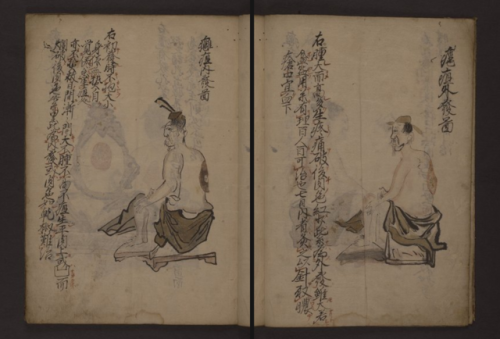


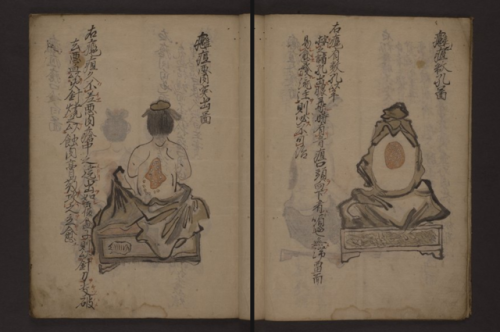



LJS 433 is a 17th century Japanese illustrated treatise on the diagnosis of abscesses and tumors and their treatment. Most of the treatments involve acupuncture or burning different substances near the skin. This manuscript, titled Yoso Zusetsu, is made with paper and written in Chinese script.
When comparing the manuscripts that we’ve looked at this week, it’s interesting to note all of the differences - from the manner in which a body is depicted (size, shape, hair style, details) to the medium and script that is used for the manuscript. Even considering how medical practices differ from culture to culture forms many implications!
I highly recommend checking out other illustrated diagrams in the full digitized version of LJS 433 on Openn: http://openn.library.upenn.edu/Data/0001/html/ljs433.html
or Penn In Hand: http://hdl.library.upenn.edu/1017/d/medren/4827745
*This week, we were taking a look at manuscripts having to do with health, medicine, and human physiology specifically focusing on how bodies are displayed in manuscript illuminations or diagrams across different cultures.
I hope you enjoyed this segment!


The Hippocratic Oath is one of the most famous pieces of medical writing, and it includes some of the basic ethical guidelines for medical practitioners. It is also constantly evolving. The images above come from a version of the oath that we found in the 1634 edition of Peter Lowe’s surgical text. If you compare it to this example of a modern version, you’ll notice some similarities and some differences. Both of them emphasize respecting the work of prior physicians and protecting the patient’s privacy. On the other hand, the modern oath doesn’t begin with an invocation to the gods, and it makes no mention of refusing to assist in abortions or any type of treatment that involves cutting. These changes illustrate how the practice of medicine, and what we expect of medical practitioners, changes over time.
New students at the Washington University School of Medicine are given the chance to devise their own student oath that is similar to the Hippocratic Oath. Take a look at the 2016 class oath here.
Tough as a Tardigrade
Without water, a human can only survive for about 100 hours. But there’s a creature so resilient that it can go without it for decades. This one millimeter animal can survive both the hottest and coldest environments on Earth, and can even withstand high levels of radiation. This is the tardigrade, and it’s one of the toughest creatures on Earth, even if it does look more like a chubby, eight-legged gummy bear.

Most organisms need water to survive. Water allows metabolism to occur, which is the process that drives all the biochemical reactions that take place in cells. But creatures like the tardigrade, also known as the water bear, get around this restriction with a process called anhydrobiosis, from the Greek meaning life without water. And however extraordinary, tardigrades aren’t alone. Bacteria, single-celled organisms called archaea, plants, and even other animals can all survive drying up.

For many tardigrades, this requires that they go through something called a tun state. They curl up into a ball, pulling their head and eight legs inside their body and wait until water returns. It’s thought that as water becomes scarce and tardigrades enter their tun state, they start synthesize special molecules, which fill the tardigrade’s cells to replace lost water by forming a matrix.

Components of the cells that are sensitive to dryness, like DNA, proteins, and membranes, get trapped in this matrix. It’s thought that this keeps these molecules locked in position to stop them from unfolding, breaking apart, or fusing together. Once the organism is rehydrated, the matrix dissolves, leaving behind undamaged, functional cells.

Beyond dryness, tardigrades can also tolerate other extreme stresses: being frozen, heated up past the boiling point of water, high levels of radiation, and even the vacuum of outer space. This has led to some erroneous speculation that tardigrades are extraterrestrial beings.

While that’s fun to think about, scientific evidence places their origin firmly on Earth where they’ve evolved over time. In fact, this earthly evolution has given rise to over 1100 known species of tardigrades and there are probably many others yet to be discovered. And because tardigrades are so hardy, they exist just about everywhere. They live on every continent, including Antarctica. And they’re in diverse biomes including deserts, ice sheets, the sea fresh water, rainforests, and the highest mountain peaks. But you can find tardigrades in the most ordinary places, too, like moss or lichen found in yards, parks, and forests. All you need to find them is a little patience and a microscope.

Scientists are now to trying to find out whether tardigrades use the tun state, their anti-drying technique, to survive other stresses. If we can understand how they, and other creatures, stabilize their sensitive biological molecules, perhaps we could apply this knowledge to help us stabilize vaccines, or to develop stress-tolerant crops that can cope with Earth’s changing climate.

And by studying how tardigrades survive prolonged exposure to the vacuum of outer space, scientists can generate clues about the environmental limits of life and how to safeguard astronauts. In the process, tardigrades could even help us answer a critical question: could life survive on planets much less hospitable than our own?
From the TED-Ed Lesson Meet the tardigrade, the toughest animal on Earth - Thomas Boothby
Animation by Boniato Studio
How Humans Change Space Itself
It’s no surprise that humans influence the surface of our planet, but our reach can go farther than that. Humans affect space, too.

We know storms from the sun can naturally change the space environment around Earth, which can have an impact on satellites and power grids.

Scientists now know that Cold War era nuclear tests in the 1950s caused similar effects.
Particles around Earth are organized into layers known as radiation belts. These 1950s tests created a temporary extra layer of radiation closer to Earth.

The effects of this could be seen all around the world. Aurora appeared at the equator instead of the poles, utility grids in Hawaii were strained, and in some cases, satellites above test sites were affected.

Some types of communications signals can also affect Earth’s radiation belts.
Very low-frequency waves, or VLFs, are used for radio communications. They are often used to communicate with submarines, because these waves can penetrate deep into the ocean.

The waves can also travel far into the space environment around Earth. When these waves are in space, they affect how high-energy particles move, creating a barrier against natural radiation.

The outer edge of this radio-wave barrier corresponds almost exactly the inner edge of Earth’s natural radiation belts – meaning it could be human activity that at least partly shapes this natural radiation around Earth.

For more NASA sun and space research, visit www.nasa.gov/sunearth and follow us on Twitter and Facebook.
Make sure to follow us on Tumblr for your regular dose of space: http://nasa.tumblr.com
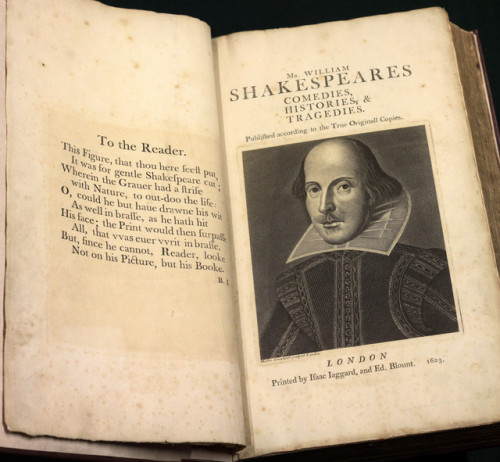
Comedies Histories Tragedies
Mr William Shakespeare
London Iaggard and Blount 1623
Textual reprint of the First Folio published by J Wright 1807






These travel booklets from throughout the UK were collected by Barbara Denison over the course of three decades, part of a larger collection consisting of dozens of volumes. Text-dense and diagram-heavy guides like these were meant to both give guidance while visiting and act as inexpensive momentos afterwards. Most of the booklets in the collection concern cathedrals, abbeys, and ruined castles that Denison visited over the course of her travels.


What the heck is ‘Johnston’s Fluid Beef’? According to this Victorian age flyer in the Canada Medical and Surgical Journal of April 1883, it is “the most perfect food for invalids ever introduced, concentrated preparation for nutritious beef tea or soup, specially recommended by the Medical Faculty.” But the directions for use on page 4 may be a recipe for botulism: “Add a small teaspoon to a cup of boiling water and season to taste; or as a sandwich paste it may be used on toast, with or without butter. The can may remain open for weeks without detriment to the contents.”
The story of ‘Johnston’s Fluid Beef’ began in 1870 in the Franco-Prussian War, when Napoleon III ordered a million cans of beef to feed troops. John Lawson Johnston, a Scot living in Montreal, had the task of providing it. Transportation and storage were problematic, so Johnston created a product known as Johnston’s Fluid Beef, later called Bovril, to meet the need. By 1888, Johnston’s Fluid Beef became a British staple sold in 3,000 U.K. public houses, grocers and dispensing chemists, and remains so today. A major downturn in sales occurred in 2004 when the company changed its formula to make Bovril vegetarian. The Guardian reported in 2007: “Rather than any new-found vegetarian gusto, the move [by Bovril] to yeast extract in 2004 was largely triggered by concerns about beef consumption and BSE [bovine spongiform encephalopathy], which affected Bovril’s export market.” But by 2006, the beef was back in Bovril and the company survives. Modern directions for use are recommended.
Molecule of the Day: Chloroform


Chloroform (CHCl3) is a colourless, dense liquid that is immiscible with water at room temperature and pressure. Popularised by movies and dramas, it is often cited as an incapacitating agent in popular culture.
Chloroform was used as a general anaesthetic due to its ability to depress the central nervous system, a property that was discovered in 1842. This produced a medically-induced coma, allowing surgeons to operate on patients without them feeling any pain.

However, chloroform was found to be associated with many side effects, such as vomiting, nausea, jaundice, depression of the respiratory system, liver necrosis and tumour formation, and its use was gradually superseded in the early 20th century by other anaesthetics and sedatives such as diethyl ether and hexobarbital respectively.

While chloroform has been implicated in several criminal cases, its use as an incapacitating agent is largely restricted to fiction; the usage of a chloroform-soaked fabric to knock a person out would take at least 5 minutes.
Chloroform is metabolised in the liver to form phosgene, which can react with DNA and proteins. Additionally, phosgene is hydrolysed to produced hydrochloric acid. These are believed to cause chloroform’s nephrotoxicity.
Chloroform is often used as a reagent to produce dichlorocarbene in situ via its reaction with a base like sodium tert-butoxide. This is a useful precursor to many derivatives. For example, the dichlorocarbene can be reacted with alkenes to form cyclopropanes, which can be difficult to synthesise otherwise.

Chloroform is industrially synthesised by the free radical chlorination of methane:
CH4 + 3 Cl2 –> CHCl3 + 3 HCl
It can also be synthesised by the reaction of acetone with sodium hypochlorite in bleach by successive aldol-like reactions:




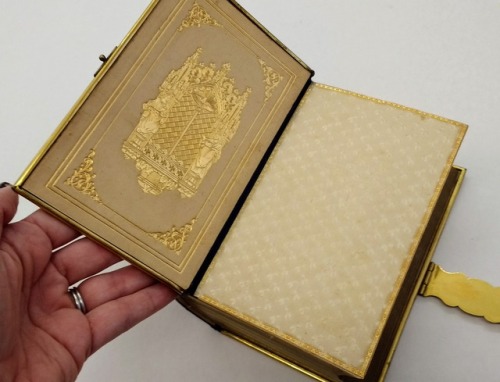

Earlier this semester, I got this book out for a class on the material culture of Christianity. It’s a beautiful Bible bound in purple velvet, with gold embellishments, edges, and clasps. It originally came in a leather case lined with silk, which has since fallen to pieces at the joints, but the same silk features on the gilded endpapers. The clasp is even engraved with the initials of the book’s first owner, Josephine Bonaparte Bolton.
This book is beautiful, but it’s even more interesting after reading the note that came with it from its donor, Josephine’s granddaughter:
When Josephine Bonaparte Bolton was sixteen years old, she taught three negro women to read and write. Her mother, Mrs. Wm. Bolton, was so proud of her daughter’s achievement, that she gave her this little Bible as a memento. The Boltons lived in Jefferson City, Missouri.
Josephine Bolton Kerns (Granddaughter)
June 1, 1977
The clasp is dated 1851, which means that the original Josephine broke Missouri law by giving reading and writing lessons to the three African American women mentioned in the note. Missouri law in 1847 stated that “No person shall keep or teach any school for the instruction of negroes or mulattos, in reading or writing, in this State.” Teaching a person of color to read was punishable by a fine of not less than $500 and up to six months in jail.
I could not find any information about either Josephine, but for the most part, the Bolton families of Cole County and Jefferson City seem to have been Confederate sympathizers. Dr. William Bolton, who may have been Josephine’s father, was a prominent Jefferson City physician and a known slave owner. I’d love to know more about Josephine, her mother, and the story behind this beautiful book. Wouldn’t you?
- Kelli
The Holy Bible, containing the Old and New Testaments : translated out of the original tongues, and with the former translations diligently compared and revised, by His Majesty’s special command, appointed to be read in churches. London : Eyre and Spottiswoode, 1848. Rare BS185 1848 .L6
Dolphins beat up octopuses before eating them, and the reason is kind of horrifying
Generally speaking, it’s best if your food doesn’t kill you. This isn’t usually a problem in the animal kingdom, as prey tends to be dead and limp by the time it hits the gullet. But not all creatures are harmless after death: consider the octopus.
Read more



On April 9, 1963, Winston Churchill was made an honorary citizen of the United States by John F. Kennedy. A most prestigious honor, it was still just one of many expressions of admiration that the British statesman was offered over the years. A 1946 letter from Churchill to Henry Luce shows him having to turn down honorary degrees from a number of prominent universities. He did, however, agree to a dinner hosted by the Time Inc. publisher at New York’s Union Club. It was a lavish affair, but not everything came off exactly as Luce might have hoped. The large ice sculpture of an eagle with its wings outstretched over mounds of black caviar was melting so quickly that a stream of water ran down the bird’s noble beak. At this Churchill remarked: “The eagle seems to have a cold.”
Winston Churchill. Letter to Henry Luce. February 26, 1946. Time Inc. Records. RG2: Bio files. New-York Historical Society.
Dinner in honor of…Winston S. Churchill…menu and seating arrangement. March 14, 1946. Time Inc. Records. RG2: Bio files. New-York Historical Society.
Processing of the Time Inc. Archive is made possible through the generous support of the Henry Luce Foundation

Around 6 million years ago, the African and Eurasian plates moved together, cutting the Mediterranean Sea off from the Atlantic. Without an influx of water from the Atlantic, evaporation began removing more water from the Mediterranean than rivers could replace. The sea dried out almost completely over the course of a couple thousand years.
About 5.3 million years ago, the Straits of Gibraltar reopened, creating a massive flood into the Mediterranean known as the Zanclean Flood. Water rushed down the straits and into the Mediterranean at speeds as high as 40 m/s (90 mph). At its peak, the Zanclean Flood is estimated to have reached rates 1000 times greater than the volumetric flow rate of the Amazon River.
A similar breach flood occurred in the Black Sea within the past 10,000 years when the Bosporus became unblocked. That flood likely had a devastating impact on Neolithic societies in the area and may be the inspiration for the floods described in the Epic of Gilgamesh and the Bible. (Image credit: BBC, source)





The Screwtape Letters C S Lewis London Geoffrey Bles - The Centenary Press 1942 - First Published February 1942, Reprinted March 1942, Reprinted March 1942
dedicated to J R R Tolkien




File Format Posters
By Corkami, “Reverse engineering & visual documentations”
The collection of images includes all kinds of formats — GIF, ZIP and WAV are all represented, but it even gets into some real esoterica — DOLphin format executables are here if you’re a total GameCube fanatic. Each poster breaks down the format into parts, such as the header, metadata and descriptor sections, and come in a variety of formats themselves — most available in SVG, PDF and PNG.
(via Hackaday)
Mae’s Millinery Shop

Photo: Photograph of Mae Reeves and a group of women standing on stairs, Collection of the Smithsonian National Museum of African American History and Culture, Gift from Mae Reeves and her children, Donna Limerick and William Mincey, Jr.
African American women have been wearing fancy hats for generations to church. In 1940, Mae Reeves started Mae’s Millinery Shop in 1940 in Philadelphia, PA with a $500 bank loan. The shop stayed open until 1997 and helped dress some of the most famous African American women in the country, including iconic singers Marian Anderson, Ella Fitzgerald and Lena Horne.
Reeves was known for making all of her customers feel welcomed and special, whether they were domestic workers, professional women, or socialites from Philadelphia’s affluent suburban Main Line. Customer’s at Mae’s would sit at her dressing table or on her settee, telling stories and sharing their troubles.

Photo: Pink mushroom hat with flowers from Mae’s Millinery Shop, Collection of the Smithsonian National Museum of African American History and Culture. In our Power of Place exhibition, we recreated a portion of Reeves’ shop to showcase this African American tradition. Our shop includes its original red-neon sign, sewing machine, antique store furniture and hats. View artifacts from Mae’s Millinery Shop in our collection: s.si.edu/2oVlbFj













